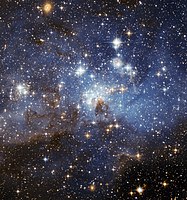
Photo from wikipedia
We report studies of the relationships between the total bolometric luminosity ($L_{\rm bol}$ or $L_{\rm TIR}$) and the molecular line luminosities of $J=1-0$ transitions of H$^{13}$CN, H$^{13}$CO$^+$, HCN, and HCO$^+$… Click to show full abstract
We report studies of the relationships between the total bolometric luminosity ($L_{\rm bol}$ or $L_{\rm TIR}$) and the molecular line luminosities of $J=1-0$ transitions of H$^{13}$CN, H$^{13}$CO$^+$, HCN, and HCO$^+$ with data obtained from ACA observations in the "ATOMS" survey of 146 active Galactic star forming regions. The correlations between $L_{\rm bol}$ and molecular line luminosities $L'_{\rm mol}$ of the four transitions all appear to be approximately linear. Line emission of isotopologues shows as large scatters in $L_{\rm bol}$-$L'_{\rm mol}$ relations as their main line emission. The log($L_{\rm bol}$/$L'_{\rm mol}$) for different molecular line tracers have similar distributions. The $L_{\rm bol}$-to-$L'_{\rm mol}$ ratios do not change with galactocentric distances ($R_{\rm GC}$) and clump masses ($M_{\rm clump}$). The molecular line luminosity ratios (HCN-to-HCO$^+$, H$^{13}$CN-to-H$^{13}$CO$^+$, HCN-to-H$^{13}$CN and HCO$^+$-to-H$^{13}$CO$^+$) all appear constant against $L_{\rm bol}$, dust temperature ($T_{\rm d}$), $M_{\rm clump}$ and $R_{\rm GC}$. Our studies suggest that both the main lines and isotopologue lines are good tracers of the total masses of dense gas in Galactic molecular clumps. The large optical depths of main lines do not affect the interpretation of the slopes in star formation relations. We find that the mean star formation efficiency (SFE) of massive Galactic clumps in the "ATOMS" survey is reasonably consistent with other measures of the SFE for dense gas, even those using very different tracers or examining very different spatial scales.
Journal Title: Monthly Notices of the Royal Astronomical Society
Year Published: 2020
Link to full text (if available)
Share on Social Media: Sign Up to like & get
recommendations!